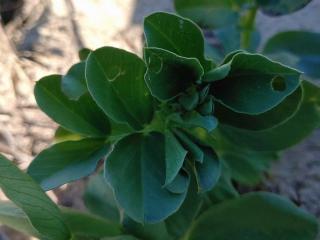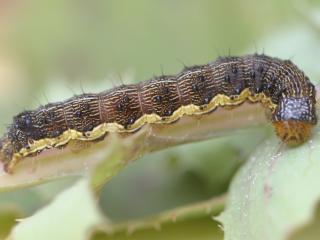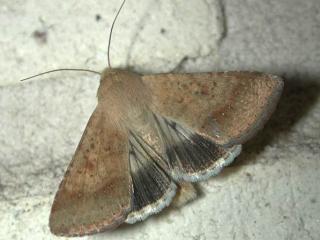Native budworm and other moths are active
- Yuna
- Mullewa
- Mingenew
- Binnu to Three Springs
- Northampton
- Northam
- Broomehill
- Grass Patch
Growers in the northern agricultural and eastern wheatbelt regions are urged to inspect their pulse and canola crops for native budworm after technical officer Dave Nicholson (DPIRD) found an average of 98 budworm caterpillars in 10 sweeps of an insect sweep net in early flowering chickpeas near Mingenew. The caterpillars were mostly about 10mm long with some up to 25mm.
Serradella, lucerne, clover and annual medic seed crops may be also be attacked, pasture crops that are intending to be harvested for seed should be regularly checked for native budworm caterpillars.
This indicates a large and early migratory flight weeks ago from the north-eastern pastoral areas where they migrate from. Dave commented that the level of damage was not very noticeable yet when walking through the crops, but these numbers could cause significant defoliation to leaves, buds and flowers in the coming 1-2 weeks.
Caterpillars eat increasing quantities of seed and plant material as they grow with the last two growths stages (5th & 6th instar 20-40mm) responsible for eating over 90 percent of their total plant consumption. The final two instars can cause considerable damage in a very short space of time.
Nick McKenna (Planfarm) has found a native budworm caterpillar in a four leaf Barlock lupin crop near Northampton. Only one caterpillar was found in the crop but Nick commented that there are a lot of moths around. Nick also found weed web moth caterpillars in a seven leaf Albus lupin crop near Northampton.
Entomologist Dusty Severtson (DPIRD) has found shot hole chewing damage to a few 4-6 leaf canola plants in a trial site near Northam. One diamondback moth (DBM) caterpillar was found on the underside of a leaf. This indicates a recent colonisation of DBM moths in the area.
Research scientist King yin Lui (DPIRD) has found low numbers of native budworm caterpillars in a Faba bean crop near Grass Patch. There was some feeding damage evident in the crop.
Chris Pinkney (Agrarian) has reported seeing a lot of moth activity in his advisory area of Binnu to Three Springs. They are flying out of all crops. Chris will be forwarding some moth samples to DPIRD for identification but at this stage the moth species are unknown.
DPIRD has again commenced the WA native budworm trapping program with manual and automated pheromone traps being set up across the grainbelt by consultants, growers and DPIRD staff.
If there is sufficient summer/autumn rainfall in the pastoral regions, large numbers of native budworm moths can build up in this area. Then given appropriate prevailing winds the moths migrate into the grain growing areas.
Budworm moth flights are normally monitored from August to October when they pose the most risk to crops wherein moths lay eggs in crops and caterpillars hatch and feed on the buds, flowers and pods of pulse and canola crops. Traps were set up early this year in anticipation of early budworm flights as occurred in the northern agricultural region in 2019.
Some early trapping results from a number automated budworm traps in the northern agricultural region, including Northampton, Mullewa, Yuna and Mingenew, have indicated that the moth flights began early again this year. This is supported by some recent reports of budworm caterpillars in crops mentioned above. Moths have also been caught in a trap at Broomehill.
Given what happened last year with high numbers of budworm moths arriving earlier than usual in some locations and causing significant damage to young crops it would be advisable to monitor crops over the coming weeks for budworm caterpillars, particularly in those areas in the northern and eastern grainbelt closer to the pastoral areas.
Identifying native budworm and other moths
Native budworm (Helicoverpa punctigera) is a major pest of pulse and canola crops in the south west of Western Australia.
Eggs laid by moths at this time of the year will take at least two to three weeks before they grow to a size of approximately 5mm long and can be detected whilst netting crops. Pulse and canola growers are encouraged to monitor their crops using a sweep net or bashing plants into a container if they are too short to sweep. Serradella, lucerne, clover and annual medic seed crops should also be regularly checked for native budworm caterpillars.
Native budworm caterpillars vary greatly in colour from green through orange to dark brown. They usually have dark stripes along the body and are sparsely covered with fine bristles.
The adult form of the native budworm is a moth that has rapid, low-level flight that takes a zig-zag path and ends with a dive into a crop or shrubs.
The moths have light brown, patterned forewings and mostly pale hind wings with a black patch at the tail end.
It is important to correctly identify moths and caterpillars to make the best management decision. Capture a moth or caterpillar then take a clear and close-up photo of the insect. Taking close-up photos of any distinguishing features that it may have, such as hairs or spots on its back, will help our entomologists make a diagnosis. You can then send an identification request via the free PestFax Reporter app or by emailing the PestFax team.
Detailed information on native budworm can be found at DPIRD’s Management and economic thresholds for native budworm page.
Pesticide options for the control of native budworm can be found in DPIRD’s Winter/Spring Insecticide Spray Chart 2019.
For more information contact Alan Lord, Technical Officer, South Perth +61 (0)8 9368 3758 or +61 (0)409 689 468.
Article authors: Cindy Webster (DPIRD Narrogin) and Alan Lord (DPIRD South Perth).
Article input: Dusty Severtson (DPIRD Northam).





